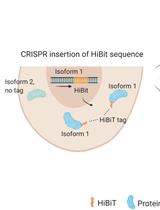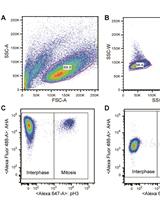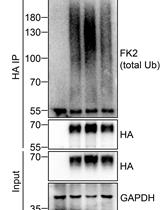- EN - English
- CN - 中文
In vitro Assessment of RNA Polymerase I Activity
RNA聚合酶I活性的体外评估
发布: 2017年02月05日第7卷第3期 DOI: 10.21769/BioProtoc.2120 浏览次数: 9602
评审: HongLok LungGaston A. PizzioAnonymous reviewer(s)

相关实验方案

通过CRISPR-Cas9介导的HiBiT标签对高度同源蛋白水平进行异构体特异性半定量测定
Kristina Seiler [...] Mario P. Tschan
2023年07月20日 2455 阅读
Abstract
In eukaryotic cells transcriptional processes are carried out by three different RNA polymerases: RNA polymerase I which specifically transcribes ribosomal RNA (rRNA), RNA polymerase II which transcribes protein-coding genes to yield messenger RNAs (mRNAs) and small RNAs, while RNA polymerase III transcribes the genes for transfer RNAs and for the smallest species of ribosomal RNA (5S rRNA). This protocol describes an in vitro assay to evaluate the rRNA transcriptional activity of RNA polymerase I. The method measures the quantity of radiolabelled uridine 5’ triphosphate incorporated in ex novo synthesized rRNA molecules by RNA polymerase I, in optimal conditions for the enzyme activity and in the presence of a toxin, α-amanitin, which inhibits RNA polymerase II and III without affecting RNA polymerase I (Novello and Stirpe, 1970).
Keywords: RNA polymerase I (RNA聚合酶I)Background
In eukaryotic cells the RNA polymerase I transcribes ribosomal genes, which are located in the nucleolus, producing 45S rRNA precursor molecules. These are processed to form the mature 18S, 5.8S and 28S rRNA. They are essential for the assembly of the 60S and the 40S subunits of mature ribosomes. Recent evidence indicates that the ribosome biogenesis rate is related to cell cycle length (Derenzini et al., 2005) and may play a role in tumorigenesis by controlling the expression of the tumour suppressor protein p53. Cells with an up-regulated ribosome biogenesis are rapidly proliferating and are characterized by a down-regulated p53 expression (Donati et al., 2011). Moreover, the ribosome biogenesis rate influences the sensitivity of cancer cells to chemotherapeutic agents which hinder rRNA transcription: higher the rate of ribosome biogenesis, higher the cytotoxic effect induced by the drug (Scala et al., 2016). Therefore, the evaluation of the ribosome biogenesis rate will become a more and more utilized procedure both in tumour pathology and in clinical oncology (Montanaro et al., 2013). Since the rate of ribosome production is tightly conditioned by the rate of 45S precursor molecules transcription, all the methods used for the evaluation of ribosome biogenesis rate measure the synthesized 45S rRNA. The used methods are: quantitative evaluation of 45S rRNA transcripts by real time PCR analysis; quantitative analysis of 45S rRNA, separated by gel electrophoresis of total RNA extracted from cells labelled with 32P-orthophosphate, and visualized by autoradiography; and quantitative evaluation of radiolabelled uridine 5’ triphosphate incorporated in ex novo synthesized rRNA molecules by RNA polymerase I. The first two methods measure the quantity of 45S rRNA present in the cells, that may be influenced by changes of rRNA processing mechanism, whereas the method described here quantifies the transcriptional activity of the RNA polymerase I and it is indicative of the rRNA transcription rate. This method is very complex and time-consuming and requires special accuracy, but it is still the only one method to selectively measure the rRNA transcription rate.
Materials and Reagents
- Cell scraper, 40 cm handle, 16 mm blade (Sigma-Aldrich, catalog number: C6106 )
- Plastic tubes 50 ml conical base (114 x 28 mm) (SARSTEDT, catalog number: 62.547.254 )
- Plastic tubes 15 ml conical base (120 x 17 mm) (SARSTEDT, catalog number: 62.554.002 )
- Plastic tubes 1.5 ml safe lock (Eppendorf, catalog number: 022363204 )
- Glass microfiber filters, diameter 25 mm, Whatman grade GF/C (GE Healthcare, catalog number: 1822-025 )
- Scintillation plastic vials (Sigma-Aldrich, catalog number: V6755 )
- Microscope slides (26 x 76 mm) (Sigma-Aldrich, catalog number: Z692247 )
- Sodium chloride (NaCl) (Sigma-Aldrich, catalog number: S3014 )
- Potassium chloride (KCl) (Sigma-Aldrich, catalog number: P9541 )
- Sodium phosphate dibasic (Na2HPO4) (Sigma-Aldrich, catalog number: S3264 )
- Potassium phosphate monobasic (KH2PO4) (Sigma-Aldrich, catalog number: P9791 )
- Hydrochloric acid (HCl) (Sigma-Aldrich, catalog number: H1758 )
- Tris base (Sigma-Aldrich, catalog number: T1503 )
- Ammonium sulfate [(NH4)2SO4] (Sigma-Aldrich, catalog number: A4418 )
- Sucrose (Merck Millipore, catalog number: 107687 )
- 1 M magnesium chloride (MgCl2) solution (Sigma-Aldrich, catalog number: M1028 )
- Triton X-100 (Sigma-Aldrich, catalog number: T8787 )
- 1 M manganese(II) chloride (MnCl2) solution (Sigma-Aldrich, catalog number: M1787 )
- Guanosine 5’-triphosphate sodium salt (GTP) (Sigma-Aldrich, catalog number: 10106399001 )
- Adenosine 5’-triphosphate disodium salt hydrate (ATP) (Sigma-Aldrich, catalog number: A7699 )
- Cytidine 5’-triphosphate disodium salt (CTP) (Sigma-Aldrich, catalog number: C1506 )
- Uridine 5’-triphosphate tri salt (UTP) (Sigma-Aldrich, catalog number: U6875 )
- Uridine 5’ triphosphate [5,6-3H] tetrasodium salt (3H-UTP) (PerkinElmer, catalog number: NET380250UC )
- α-amanitin (Sigma-Aldrich, catalog number: A2263 )
- Liquid scintillation cocktail Hionic Fluor (PerkinElmer, catalog number: 6013319 )
- Trichloroacetic acid (TCA) (Sigma-Aldrich, catalog number: T4885 )
- Perchloric acid (PCA) 65% w/w (10.35 N) (CARLO ERBA Reagents, catalog number: 306091 )
- Potassium hydroxide (KOH) (EMD Millipore, catalog number: 105033 )
- 2-mercaptoethanol (EMD Millipore, catalog number: 805740 )
- Sodium fluoride (NaF) (Sigma-Aldrich, catalog number: S7920 )
- PBS (pH 7.3) (see Recipe 1)
- 1 M Tris-HCl solution (pH 7.4 or pH 8.0) (see Recipe 2)
- 3 M ammonium sulfate (see Recipe 3)
- Homogenization-solution (see Recipe 4)
- Washing solution (see Recipe 5)
- Suspension solution (see Recipe 6)
- High ionic strength 5x reaction mixture (see Recipe 7)
- Nucleoside triphosphate mixture (see Recipe 8)
- Non-radioactive solution
- Radioactive solution
- α-amanitin reconstitution (see Recipe 9)
- 10% (w/w) TCA (see Recipe 10)
- 0.6 N PCA (see Recipe 11)
- 0.3 N KOH (see Recipe 12)
- 6 N PCA (see Recipe 13)
- 7% (w/w) PCA (see Recipe 14)
- 0.5 M NaF (see Recipe 15)
- Low ionic strength 5x reaction mixture (see Recipe 16)
Equipment
- Protective gloves/protective clothing/eye protection/face protection
- Centrifuge (Beckman Coulter, model: TJ-25 )
Note: This product has been discontinued. - Teflon® pestle PYREX® Potter-Elvehjem tissue grinder (Thomas Scientific, catalog number: 1234F )
- Forceps
- High speed tissue grinder (homogenizer) (IKA, model: Eurostar )
- Inverted microscope (Zeiss, model: Primovert, catalog number: 491206-0001-000 )
- 10 ml glass tubes
- Shaking water bath (JULABO, model: SW22 )
- 2,000 ml filter flask
- Spectrophotometer UV-VIS (CHROMSERVIS, model: Nanogenius )
- Liquid scintillation counter (Guardian, Wallac, PerkinElmer)
- Vacuum glass filter holder for 25 mm disc filters elements: glass funnel, clamp, base for 25 mm glass/filter holder and a perforated stopper (available from many companies, for example: Sigma-Aldrich, catalog number: Z290467 ; EMD Millipore, catalog number: XX1002500 )
- Vacuum pump
Procedure
文章信息
版权信息
© 2017 The Authors; exclusive licensee Bio-protocol LLC.
如何引用
Govoni, M. (2017). In vitro Assessment of RNA Polymerase I Activity. Bio-protocol 7(3): e2120. DOI: 10.21769/BioProtoc.2120.
分类
癌症生物学 > 通用技术 > 生物化学试验 > 蛋白质分析
生物化学 > 蛋白质 > 活性
您对这篇实验方法有问题吗?
在此处发布您的问题,我们将邀请本文作者来回答。同时,我们会将您的问题发布到Bio-protocol Exchange,以便寻求社区成员的帮助。
Share
Bluesky
X
Copy link












